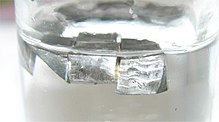Lithium (from Greek: λίθος, romanized: lithos, lit. 'stone') is a chemical element with the symbol Li and atomic number 3. It is a soft, silvery-white alkali metal. Under standard conditions, it is the least dense metal and the least dense solid element. Like all alkali metals, lithium is highly reactive and flammable and must be stored in a vacuum, inert atmosphere, or inert liquid such as purified kerosene or mineral oil. When cut, it exhibits a metallic luster, but moist air corrodes it quickly to a dull silvery gray, then black tarnish. It never occurs freely in nature, but only in (usually ionic) compounds, such as pegmatitic minerals, which were once the main source of lithium. Due to its solubility as an ion, it is present in ocean water and is commonly obtained from brines. Lithium metal is isolated electrolytically from a mixture of lithium chloride and potassium chloride.
The nucleus of the lithium atom verges on instability since the two stable lithium isotopes found in nature have among the lowest binding energies per nucleon of all stable nuclides. Because of its relative nuclear instability, lithium is less common in the solar system than 25 of the first 32 chemical elements even though its nuclei are very light: it is an exception to the trend that heavier nuclei are less common.[4] For related reasons, lithium has important uses in nuclear physics. The transmutation of lithium atoms to helium in 1932 was the first fully man-made nuclear reaction, and lithium deuteride serves as a fusion fuel in staged thermonuclear weapons.[5]
Lithium and its compounds have several industrial applications, including heat-resistant glass and ceramics, lithium grease lubricants, flux additives for iron, steel, and aluminum production, lithium metal batteries, and lithium-ion batteries. These uses consume more than three-quarters of lithium production.
Lithium is present in biological systems in trace amounts; its functions are uncertain. Lithium salts have proven to be useful as a mood stabilizer and antidepressant in the treatment of mental illnesses such as bipolar disorder.
 Lithium floating in oil | ||||||||||||||||||||||||
| Lithium | ||||||||||||||||||||||||
|---|---|---|---|---|---|---|---|---|---|---|---|---|---|---|---|---|---|---|---|---|---|---|---|---|
| Pronunciation | /ˈlɪθiəm/ | |||||||||||||||||||||||
| Appearance | silvery-white | |||||||||||||||||||||||
| Standard atomic weight Ar°(Li) | ||||||||||||||||||||||||
| ||||||||||||||||||||||||
| Lithium in the periodic table | ||||||||||||||||||||||||
| ||||||||||||||||||||||||
| Atomic number (Z) | 3 | |||||||||||||||||||||||
| Group | group 1: hydrogen and alkali metals | |||||||||||||||||||||||
| Period | period 2 | |||||||||||||||||||||||
| Block | s-block | |||||||||||||||||||||||
| Electron configuration | [He] 2s1 | |||||||||||||||||||||||
| Electrons per shell | 2, 1 | |||||||||||||||||||||||
| Physical properties | ||||||||||||||||||||||||
| Phase at STP | solid | |||||||||||||||||||||||
| Melting point | 453.65 K (180.50 °C, 356.90 °F) | |||||||||||||||||||||||
| Boiling point | 1603 K (1330 °C, 2426 °F) | |||||||||||||||||||||||
| Density (near r.t.) | 0.534 g/cm3 | |||||||||||||||||||||||
| when liquid (at m.p.) | 0.512 g/cm3 | |||||||||||||||||||||||
| Critical point | 3220 K, 67 MPa (extrapolated) | |||||||||||||||||||||||
| Heat of fusion | 3.00 kJ/mol | |||||||||||||||||||||||
| Heat of vaporization | 136 kJ/mol | |||||||||||||||||||||||
| Molar heat capacity | 24.860 J/(mol·K) | |||||||||||||||||||||||
Vapor pressure
| ||||||||||||||||||||||||
| Atomic properties | ||||||||||||||||||||||||
| Oxidation states | 0[2], +1 (a strongly basicoxide) | |||||||||||||||||||||||
| Electronegativity | Pauling scale: 0.98 | |||||||||||||||||||||||
| Ionization energies |
| |||||||||||||||||||||||
| Atomic radius | empirical: 152 pm | |||||||||||||||||||||||
| Covalent radius | 128±7 pm | |||||||||||||||||||||||
| Van der Waals radius | 182 pm | |||||||||||||||||||||||
| Spectral lines of lithium | ||||||||||||||||||||||||
| Other properties | ||||||||||||||||||||||||
| Natural occurrence | primordial | |||||||||||||||||||||||
| Crystal structure | body-centered cubic (bcc) | |||||||||||||||||||||||
| Speed of soundthin rod | 6000 m/s (at 20 °C) | |||||||||||||||||||||||
| Thermal expansion | 46 µm/(m⋅K) (at 25 °C) | |||||||||||||||||||||||
| Thermal conductivity | 84.8 W/(m⋅K) | |||||||||||||||||||||||
| Electrical resistivity | 92.8 nΩ⋅m (at 20 °C) | |||||||||||||||||||||||
| Magnetic ordering | paramagnetic | |||||||||||||||||||||||
| Molar magnetic susceptibility | +14.2×10−6 cm3/mol (298 K)[3] | |||||||||||||||||||||||
| Young's modulus | 4.9 GPa | |||||||||||||||||||||||
| Shear modulus | 4.2 GPa | |||||||||||||||||||||||
| Bulk modulus | 11 GPa | |||||||||||||||||||||||
| Mohs hardness | 0.6 | |||||||||||||||||||||||
| Brinell hardness | 5 MPa | |||||||||||||||||||||||
| CAS Number | 7439-93-2 | |||||||||||||||||||||||
| History | ||||||||||||||||||||||||
| Discovery | Johan August Arfwedson (1817) | |||||||||||||||||||||||
| First isolation | William Thomas Brande (1821) | |||||||||||||||||||||||
| Main isotopes of lithium | ||||||||||||||||||||||||
| ||||||||||||||||||||||||
